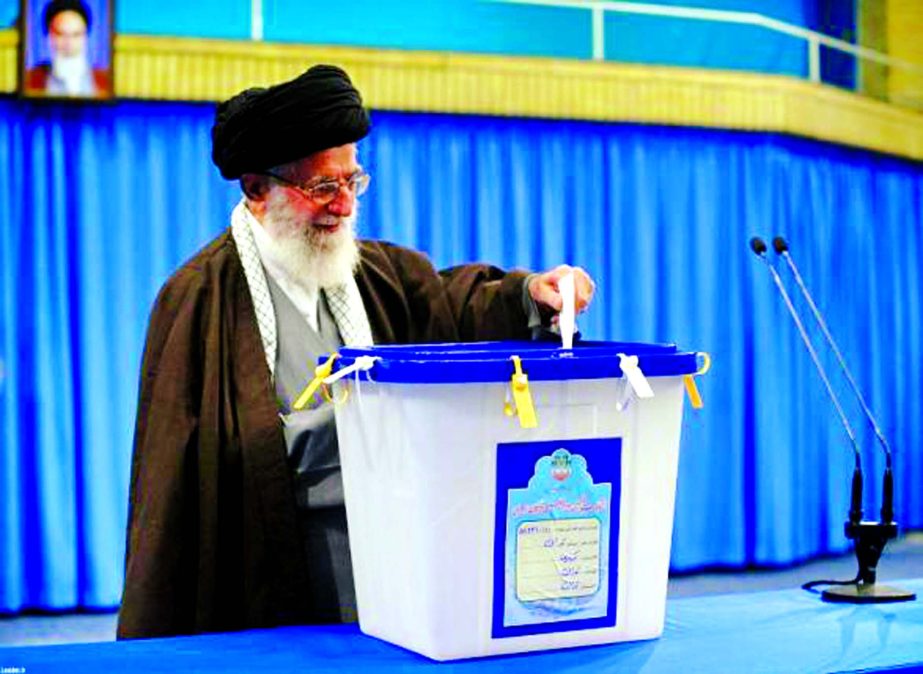
Al Jazeera News :
Iranians cast their ballots to elect new members of parliament and a council of clerics in elections seen as a referendum on President Hassan Rouhani’s rule.
An estimated 50 million people are eligible to vote on a pre-selected list of candidates during the polls on Friday. The elections take place just a month after years of economic sanctions against the country were lifted.
Surveys indicated a higher turnout than at the previous parliamentary polls four years ago, but lower than the presidential contest that elected Rouhani in 2013. Voting started at 8am local time (04:30 GMT).
Rouhani said he had reports of a high turnout, the official IRNA news agency reported.
“Election is a symbol of the political independence of a country. By voting people decide the future of their country,” Rouhani was quoted as saying after casting his vote.
The parliament, also known as the Majlis, has 290 members who are responsible for passing legislation in the country, approving the annual budget and international agreements, including the recent nuclear deal with the West. Al Jazeera’s Andrew Simmons, reporting from a packed polling station in Tehran,described the vote as a litmus test for Rouhani’s signature move – the nuclear deal with the West and the subsequent lifting of economic sanctions that had strangled its economy.
“This whole business right now is colossal for Iran. This about the influence of Rouhani and his more moderate policies – reformist policies that he wants to bring through against the conservatives,” Simmons said.
The council of clerics, also known as the Assembly of Experts, is composed of 88 members who will pick the next Supreme Leader in case of a vacancy. Members serve for eight years.
The current Supreme Leader, Ayatollah Ali Khamenei, is 76 and has a history of health issues, making the role of this elected body crucial. Among the most prominent candidates are Rouhani and former President Hashemi Rafsanjani. Hassan Khomeini, a reformist and grandson of the first Supreme Leader, Ayatollah Ruhollah Khomeini, was disqualified. Last week, the Guardian Council – the electoral body under the Supreme Leader – disqualified almost half of the 12,000 candidates. A total 6,229 were allowed to run including 586 women – or 9.4 percent of the total candidates.
Hopefuls only had one week to campaign from February 18 to last Wednesday, giving establishment candidates the advantage and party backing. Some 250 parties are registered. An estimated 60 percent of Iran’s 81 million population is 30 years old or younger.
Among the the most pressing issues in the elections are the economy, foreign affairs, and human rights.
In 2015, the country faced 15.3 percent inflation. An estimated 25 percent of its youth are unemployed.
With the lifting of sanctions, Iran aims to improve its economy by producing an additional one million barrels per day (bpd) of oil in 2016, and return to the 3.5 million bpd level it produced before economic sanctions were imposed in 2011 and 2012.
Iranians cast their ballots to elect new members of parliament and a council of clerics in elections seen as a referendum on President Hassan Rouhani’s rule.
An estimated 50 million people are eligible to vote on a pre-selected list of candidates during the polls on Friday. The elections take place just a month after years of economic sanctions against the country were lifted.
Surveys indicated a higher turnout than at the previous parliamentary polls four years ago, but lower than the presidential contest that elected Rouhani in 2013. Voting started at 8am local time (04:30 GMT).
Rouhani said he had reports of a high turnout, the official IRNA news agency reported.
“Election is a symbol of the political independence of a country. By voting people decide the future of their country,” Rouhani was quoted as saying after casting his vote.
The parliament, also known as the Majlis, has 290 members who are responsible for passing legislation in the country, approving the annual budget and international agreements, including the recent nuclear deal with the West. Al Jazeera’s Andrew Simmons, reporting from a packed polling station in Tehran,described the vote as a litmus test for Rouhani’s signature move – the nuclear deal with the West and the subsequent lifting of economic sanctions that had strangled its economy.
“This whole business right now is colossal for Iran. This about the influence of Rouhani and his more moderate policies – reformist policies that he wants to bring through against the conservatives,” Simmons said.
The council of clerics, also known as the Assembly of Experts, is composed of 88 members who will pick the next Supreme Leader in case of a vacancy. Members serve for eight years.
The current Supreme Leader, Ayatollah Ali Khamenei, is 76 and has a history of health issues, making the role of this elected body crucial. Among the most prominent candidates are Rouhani and former President Hashemi Rafsanjani. Hassan Khomeini, a reformist and grandson of the first Supreme Leader, Ayatollah Ruhollah Khomeini, was disqualified. Last week, the Guardian Council – the electoral body under the Supreme Leader – disqualified almost half of the 12,000 candidates. A total 6,229 were allowed to run including 586 women – or 9.4 percent of the total candidates.
Hopefuls only had one week to campaign from February 18 to last Wednesday, giving establishment candidates the advantage and party backing. Some 250 parties are registered. An estimated 60 percent of Iran’s 81 million population is 30 years old or younger.
Among the the most pressing issues in the elections are the economy, foreign affairs, and human rights.
In 2015, the country faced 15.3 percent inflation. An estimated 25 percent of its youth are unemployed.
With the lifting of sanctions, Iran aims to improve its economy by producing an additional one million barrels per day (bpd) of oil in 2016, and return to the 3.5 million bpd level it produced before economic sanctions were imposed in 2011 and 2012.

